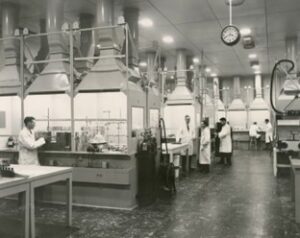When the National Research Experimental (NRX) reactor came on line in July 1947, it was the premier irradiation facility in the world. Its flux exceeded that of other reactors by a factor of ten. One of the main advantages of the high flux was the decrease in the amount of material that would have to be irradiated and handled to produce the amount of an isotope a researcher wanted to study.
In a Progress Report sent to the Head Office of the National Research Council three short months after the startup of NRX, Dr. Keys reported: “Various isotopes have been produced and the first shipment from the Plant was on 1947 October 31, to the University of Saskatchewan. Small quantities of P-32, C-14, I-131 and S-35 are on hand and samples are being prepared of H-3, Ca-45, As-75, Sn-89, Ag-108, Sb-124 and Ce-144. Dr. L.G. Cook, in addition to his duties as head of the Chemical Research Branch, is acting as head of the Isotope Distribution Branch.”
Unfortunately, politics played a large role in the timing of Canadian entry into the international isotope market. Decisions were made high up the political chain, to disallow the export of isotopes until the USA was able to do so, in spite of the federal government authorization to construct a dedicated laboratory for isotope production at Chalk River.
By mid-1949 NRX was producing a significant quantity of Co-60 and arrangements were made with Eldorado Mining and Smelting Company, to distribute this isotope to customers looking for the material for radiographic work and as a substitute for radium in cancer treatments. The lead person from Eldorado in this effort was Roy Errington, who was later to head the Commercial Products Division of AECL.
In 1950 arrangements were made for the Charles E. Frosst Co. to handle all requests for isotopes which were to be used for clinical purposes. This arrangement relieved Chalk River of the necessity of final purification.
During mid-1951 a strong source of Co-60 was shipped to Dr. H.E. Johns at Saskatoon for his pioneering work at the Saskatchewan Cancer Commission.
Isotope production continued to increase, and in an August 1952 Dr. Keys reported: “The Isotope Production Branch has been able to meet all requirements for both Canadian and external orders. The amount of high-specific-activity Co-60 which can be produced is limited by reactor loading. More than 300 shipments have been made over the past two months, a sixth of these to outside countries. Since the USA, Britain, France and Norway now all have reactors in operation, and supply isotopes, it is mostly in cases where high specific activity is required that foreign requests are made. Among industrial applications, isotopes are used in radiography, thickness gauges, electrostatic eliminators, and as tracers.”
The start up of the National Research Universal (NRU) reactor in 1957 greatly increased the number and volume of isotopes Chalk River was able to supply the world. This was especially true for Co-60.
As time went on, radioactive isotopes began to play an increasing role in medical diagnostics with Mo-99 leading the way and by 2009, NRU, which had become the workhorse for the Chalk River isotope production program, was producing over 60% of the world’s need for this isotope. Production was halted that year when a leak in the calandria of NRU appeared, resulting in an acute global shortage of the isotope. An all-out effort led to successful repairs of the calandria, and NRU continued to supply a major portion of the world market for Mo-99 until October 2016, and the reactor was shut permanently on 2018 Mar 31.
Isotope production no longer plays a major role in the activities at Chalk River. There is an on-going effort investigating short-lived alpha emitters, such as actinium-225 (Ac-225) that can be injected into cancerous tumors to treat them, but no significant production capabilities presently exist.
To learn more about the past isotope programs the reader is invited to browse the extensive documents collection at the Canadian Nuclear Heritage Museum. To arrange a visit, send an email to info@nucearheritage.com.

Isotope separation lab at Chalk River (1950)
